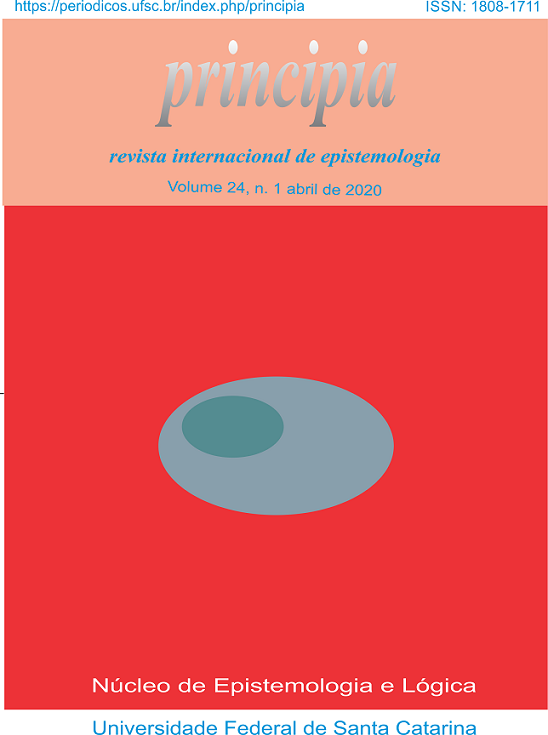A deductive-nomological model for mathematical scientific explanation
DOI:
https://doi.org/10.5007/1808-1711.2020v24n1p1Abstract
I propose a deductive-nomological model for mathematical scientific explanation. In this regard, I modify Hempel’s deductive-nomological model and test it against some of the following recent paradigmatic examples of the mathematical explanation of empirical facts: the seven bridges of Königsberg, the North American synchronized cicadas, and Hénon-Heiles Hamiltonian systems. I argue that mathematical scientific explanations that invoke laws of nature are qualitative explanations, and ordinary scientific explanations that employ mathematics are quantitative explanations. I analyse the repercussions of this deductivenomological model on causal explanations.
References
Achinstein, P. (1971). Law and Explanation. Oxford: Oxford University Press.
Argyris, J. H., Faust, G., Haase, M., & Friedrich, R. (2015). An Exploration of Dynamical Systems and Chaos. Berlin, Heidelberg: Springer Berlin Heidelberg. Accessed 22 February 2016
Baker, A. (2005). Are there Genuine Mathematical Explanations of Physical Phenomena? Mind, 114(454), 223–238. doi:10.1093/mind/fzi223
Baker, A. (2012). Science-Driven Mathematical Explanation. Mind, 121(482), 243–267. doi:10.1093/mind/fzs053
Baron, S. (n.d.). Mathematical Explanation by Law. The British Journal for the Philosophy of Science. doi:10.1093/bjps/axx062
Bromberger, S. (1966). Why-Questions. In R. Colodny (Ed.), Mind and Cosmos: Essays in Contemporary Science and Philosophy (pp. 86–111). Pittsburgh: University of Pittsburgh Press.
Colyvan, M. (2001). The Indispensability of Mathematics. New York: Oxford University Press.
Daly, C., & Langford, S. (2009). Mathematical Explanation and Indispensability Arguments. The Philosophical Quarterly, 59(237), 641–658. doi:10.1111/j.1467-9213.2008.601.x
Dedò, M. (2017). Q for Qualitative Mathematics. Lettera Matematica 5(2), 167–171. doi:10.1007/s40329-017-0182-4.
Díez, J. (2014). Scientific w-Explanation as Ampliative, Specialized Embedding: A Neo-Hempelian Account. Erkenntnis, 79(8), 1413–1443. doi:10.1007/s10670-013-9575-8
Field, H. (1980). Science Without Numbers. Princeton, NJ: Princeton University Press.
Frege, G. (1884). Der Grundlagen die Arithmetik. Breslau: W. Koebner.
Frigg, R. (2004). In What Sense Is the Kolmogorov-Sinai Entropy a Measure for Chaotic Behaviour? Bridging the Gap between Dynamical Systems Theory and Communication Theory. The British Journal for the Philosophy of Science, 55(3), 411–434.
Goles, E., Schulz, O., & Markus, M. (2001). Prime number selection of cycles in a predator-prey model. Complexity, 6(4), 33–38. doi:10.1002/cplx.1040
Hempel, C. (1964). On the Nature of Mathematical Truth. In P. B. H. Putnam (Ed.), Philosophy of Mathematics (pp. 377–393). Cambridge University Press.
Hempel, C. (1965). Aspects of Scientific Explanation and Other Essays in the Philosophy of Science. New York: The Free Press.
Hénon, M. (1988). Citation Classic - The Applicability of the 3rd Integral of Motion - Some Numerical Experiments. Current Contents/Phys Chem Earth, 4, 18.
Hénon, M., & Heiles, C. (1964). The Applicability of the Third Integral of Motion: Some Numerical Experiments. The Astronomical Journal, 69(1), 73–79.
Jackson, F., & Pettit, P. (1990). Program Explanation: A General Perspective. Analysis, 50(2), 107–117. doi:10.2307/3328853
Lange, M. (2013). What Makes a Scientific Explanation Distinctively Mathematical? British Journal for the Philosophy of Science, 64(3), 485–511.
Lewis, D. (1986). Philosophical Papers: Volume II. New York: Oxford University Press.
Lyon, A. (2012). Mathematical Explanations of Empirical Facts, And Mathematical Realism. Australasian Journal of Philosophy, 90(3), 559–578.
Lyon, A., & Colyvan, M. (2007). The Explanatory Power of Phase Spaces. Philosophia Mathematica, 16(2), 227–243. doi:10.1093/philmat/nkm025
Malament, D. (1982). Review of: Science Without Numbers: A Defense of Nominalism. by Hartry H. Field. The Journal of Philosophy, 79(9), 523–534. doi:10.2307/2026384
Molinini, D. (2014). Deductive Nomological Model and Mathematics: Making Dissatisfaction more Satisfactory. THEORIA. An International Journal for Theory, History and Foundations of Science, 29(2), 223. doi:10.1387/theoria.6464
Pincock, C. (2007). A Role for Mathematics in the Physical Sciences. Noûs, 41(2), 253–275. doi:10.1111/j.1468-0068.2007.00646.x
Poincaré, H. (1921). Foundations of Science. New York: The Science Press.
Salmon, W. (1984). Scientific Explanation and the Causal Structure of the World. Princeton: Princeton University Press.
Salmon, W. (1989). Four Decades of Scientific Explanation. Pittsburgh: University of Pittsburgh Press.
Scriven, M. (1962). Explanations, predictions, and laws. In H. Feigl & G. Maxwell (Eds.), Scientific Explanation, Space, and Time (Minnesota Studies in the Philosophy of Science) (Vol. 3, pp. 170–230). Minneapolis: University of Minnesota Press.
Steiner, M. (1978). Mathematics, Explanation, and Scientific Knowledge. Noûs, 12(1), 17–28. doi:10.2307/2214652
Steiner, M. (2002). The Applicability of Mathematics as a Philosophical Problem. Cambridge, Mass.: Harvard University Press.
Yoshimura, J. (1997). The evolutionary origins of periodical cicadas during ice ages. American Naturalist, 149(1), 112.
Downloads
Published
Issue
Section
License

Principia http://www.periodicos.ufsc.br/index.php/principia/index is licenced under a Creative Commons - Atribuição-Uso Não-Comercial-Não a obras derivadas 3.0 Unported.
Base available in www.periodicos.ufsc.br.



